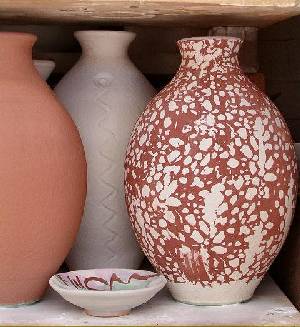 |
A great decoration tool is a paint roller !
I use a variety of them when I decorate. The standard 4" paint roller can be used to edge a large bowl/platter while you spin it slowly on a turn table (see my tools suggestion for an inexpensive idea). Or you can get fancy ... Explore the options at your local hardware store ... this vase was glazed and then an accent color rolled on with a roller that was (I guess) designed to give some fancy/faux paint treatment to a wall. Today there are a multiple of options for paint rollers that, if you haven't been to the store lately, you are probably not even aware exist ... they can be excellent additions to your surface decoration options. |
|
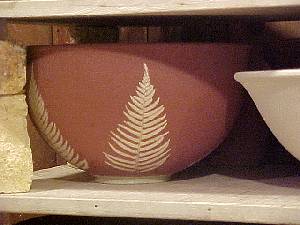 |
Another nice touch is the leaf ... here I use a fern as a "resist" while I glaze a large bowl. You can use a variety of leaves though you should pick ones with some structure (and if possible a strong central stem) so that you can remove them easily without tearing. The fern is ideal ...
After I pick the leaves I store them in an old phone book to both keep them pressed flat and to take most of the moisture out of them. Then when I'm ready to glaze, I spray the smoothest side with some standard spray-glue (3M Spra-Ment) and apply it to the piece, glaze normally and as soon as the glaze is dry I peal off the leaf carefully ... this will take a few times to perfect the time-delays and pealing technique. |
|
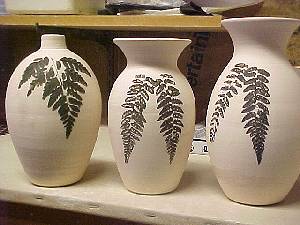 |
Once you have a collection of leaves there are more things you can do with them ... this effect is done while the pot is still wet. I take the leaf (here the same fern as above), place it with the most textured side up on a bat, apply a thin (~1/16") coat of slip or engobe to the leaf, and then carefully place it onto the damp pot (not immediately off the wheel, but when it is firm but not hard). Once in place (this is a one shot deal if you have mixed any oxide into the slip/engobe), you carefully press each leaf segment down with a rubber tipped tool so that the slip/engobe presses slightly around the edge of the leaf. Nothing else to do as the leaf will simply burn out when you bisque leaving a wonderful patterned leaf on the pot ... | |
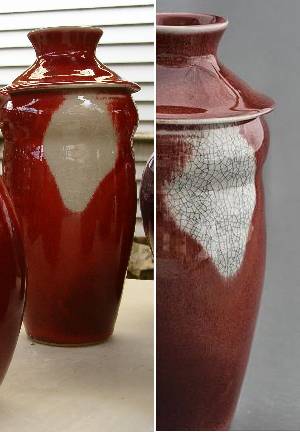 |
OK ... so if you venture into copper red glazes at some point you are going to end up with the big white nothing !
While there are as many stories/reasons for why this happens as there are potters you may ask ... the obvious thing is what to do next. Once the pot is cooled and the glaze has cracked (which most copper reds will do) I simply rub good ole fashion india ink into the cracks and then wipe it off. The black seeps into the minute cracks and produces a wonderful patterned effect that looks like it was intentional. In fact, the Japanese often do this but with very strong tea as a colorant ... you can try different things should you be adventurous. |
|
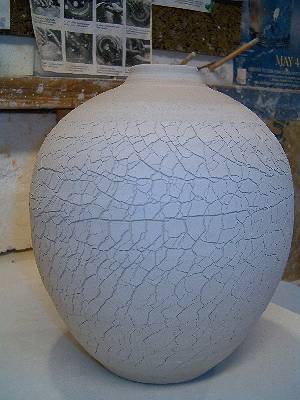 |
||
 |
Once you start into making soup/cereal bowls you'll be faced with the fact that they have to nest ... not only will your customers expect this, but it makes packing bowls in boxes (for shows/etc) much easier if they fit inside each other well.
The trick I was taught (by Huff Jones) was what is knows as "throwing to the stick" and it is exactly what the name implies. First you must determine the size (diameter and height) of the bowls you are going to throw, then you take a chopstick and mount it to your splash pan so that the tip is exactly those dimensions from the center of the bat. |
|